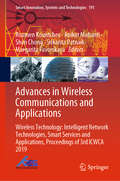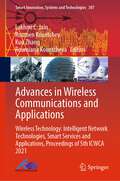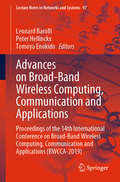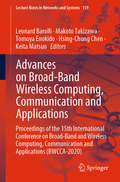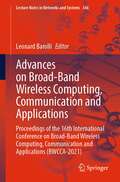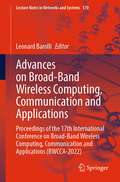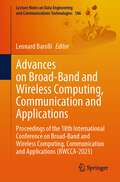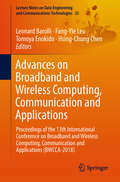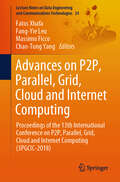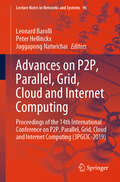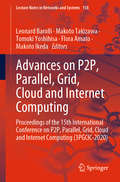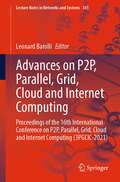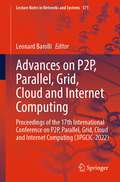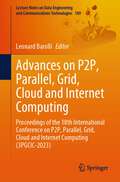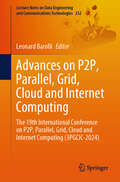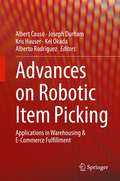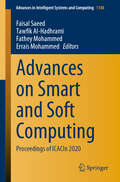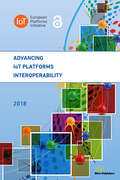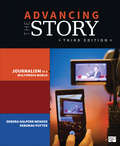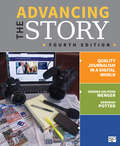- Table View
- List View
Advances in Wireless Communications and Applications: Wireless Technology: Intelligent Network Technologies, Smart Services and Applications, Proceedings of 3rd ICWCA 2019 (Smart Innovation, Systems and Technologies #191)
by Srikanta Patnaik Margarita Favorskaya Roumen Kountchev Aniket Mahanti Shen ChongThis book gathers selected papers presented at the 3rd International Conference on Wireless Communications and Applications (ICWCA 2019), held at Hainan University, China. It covers up-to-date smart theories and approaches, as reflected in contemporary technical achievements in the area. The topics covered include: software-defined networking (SDN) and network function virtualization (NFV), future data center networks, 5G/6G mobile networks, QoS/QoE support in future networks, future Internet of things (IoT) networks, network fault management and service availability, and many others.
Advances in Wireless Communications and Applications: Wireless Technology: Intelligent Network Technologies, Smart Services and Applications, Proceedings of 5th ICWCA 2021 (Smart Innovation, Systems and Technologies #307)
by Lakhmi C. Jain Roumen Kountchev Kun Zhang Roumiana KountchevaThis book features selected papers presented at the 5th International Conference on Wireless Communications and Applications (ICWCA 2021), held at Hainan University, China. The book will focus on the presentation of the newest trends and achievements in the development of intelligent algorithms and network technologies in smart communications, with application in underwater communications, IoT-based marine surface communications as well as state-of-the-art real-time precise location technologies, WiFi/Bluetooth locationing, array signal processing and many others.
Advances on Broad-Band Wireless Computing, Communication and Applications: Proceedings of the 14th International Conference on Broad-Band Wireless Computing, Communication and Applications (BWCCA-2019) (Lecture Notes on Data Engineering and Communications Technologies #97)
by Leonard Barolli Tomoya Enokido Peter HellinckxThis proceedings book presents the latest research findings, innovative research results, methods and development techniques related to the emerging areas of broadband and wireless computing, from both theoretical and practical perspectives. Today’s information networks are going through a rapid evolution. Different kinds of networks with different characteristics are emerging, and are being integrated into heterogeneous networks. As a result, there are numerous interconnection problems that can occur at different levels of the hardware and software design of communicating entities and communication networks. Such networks need to manage an increasing usage demand, provide support for a significant number of services, guarantee their QoS, and optimize the network resources. The success of all-IP networking and wireless technology has changed the way of living for people around the globe. Advances in electronic integration and wireless communications will pave the way to offering access to wireless networks on the fly, which in turn will allow electronic devices to share information with each other wherever and whenever necessary.
Advances on Broad-Band Wireless Computing, Communication and Applications: Proceedings of the 15th International Conference on Broad-Band and Wireless Computing, Communication and Applications (BWCCA-2020) (Lecture Notes in Networks and Systems #159)
by Makoto Takizawa Leonard Barolli Tomoya Enokido Hsing-Chung Chen Keita MatsuoThis book aims to provide the latest research findings, innovative research results, methods and development techniques from both theoretical and practical perspectives related to the emerging areas of broadband and wireless computing. Information networks of today are going through a rapid evolution. Different kinds of networks with different characteristics are emerging, and they are integrating in heterogeneous networks. For these reasons, there are many interconnection problems which may occur at different levels of the hardware and software design of communicating entities and communication networks. These kinds of networks need to manage an increasing usage demand, provide support for a significant number of services, guarantee their QoS, and optimize the network resources. The success of all-IP networking and wireless technology has changed the ways of living the people around the world. The progress of electronic integration and wireless communications is going to pave the way to offer people the access to the wireless networks on the fly, based on which all electronic devices will be able to exchange the information with each other in ubiquitous way whenever necessary.
Advances on Broad-Band Wireless Computing, Communication and Applications: Proceedings of the 16th International Conference on Broad-Band Wireless Computing, Communication and Applications (BWCCA-2021) (Lecture Notes in Networks and Systems #346)
by Leonard BarolliThis book states that information networks of today are going through a rapid evolution. Different kinds of networks with different characteristics are emerging and they are integrating in heterogeneous networks. For these reasons, there are many interconnection problems which may occur at different levels of the hardware and software design of communicating entities and communication networks. These kinds of networks need to manage an increasing usage demand, provide support for a significant number of services, guarantee their QoS, and optimize the network resources. The success of all-IP networking and wireless technology has changed the ways of living the people around the world. The progress of electronic integration and wireless communications is going to pave the way to offer people the access to the wireless networks on the fly, based on which all electronic devices will be able to exchange the information with each other in ubiquitous way whenever necessary.The aim of the book is to provide latest research findings, innovative research results, methods, and development techniques from both theoretical and practical perspectives related to the emerging areas of broad-band and wireless computing.
Advances on Broad-Band Wireless Computing, Communication and Applications: Proceedings of the 17th International Conference on Broad-Band Wireless Computing, Communication and Applications (BWCCA-2022) (Lecture Notes in Networks and Systems #570)
by Leonard BarolliThis book aims to provide latest research findings, innovative research results, methods, and development techniques from both theoretical and practical perspectives related to the emerging areas of broadband and wireless computing. Information networks of today are going through a rapid evolution. Different kinds of networks with different characteristics are emerging, and they are integrating in heterogeneous networks. For these reasons, there are many interconnection problems which may occur at different levels of the hardware and software design of communicating entities and communication networks. These kinds of networks need to manage an increasing usage demand, provide support for a significant number of services, guarantee their QoS, and optimize the network resources. The success of all-IP networking and wireless technology has changed the ways of living the people around the world. The progress of electronic integration and wireless communications is going to pave the way to offer people the access to the wireless networks on the fly, based on which all electronic devices will be able to exchange the information with each other in ubiquitous way whenever necessary.
Advances on Broad-Band Wireless Computing, Communication and Applications: The 19th International Conference on Broadband and Wireless Computing, Communication and Applications (BWCCA-2024) (Lecture Notes on Data Engineering and Communications Technologies #231)
by Leonard BarolliThis book aims to provide latest research findings, innovative research results, methods, and development techniques from both theoretical and practical perspectives related to the emerging areas of broadband and wireless computing. Information networks of today are going through a rapid evolution. Different kinds of networks with different characteristics are emerging and they are integrating in heterogeneous networks. For these reasons, there are many interconnection problems which may occur at different levels of the hardware and software design of communicating entities and communication networks. These kinds of networks need to manage an increasing usage demand, provide support for a significant number of services, guarantee their QoS, and optimize the network resources. The success of all-IP networking and wireless technology has changed the ways of living the people around the world. The progress of electronic integration and wireless communications is going to pave the way to offer people the access to the wireless networks on the fly, based on which all electronic devices will be able to exchange the information with each other in ubiquitous way whenever necessary.
Advances on Broad-Band and Wireless Computing, Communication and Applications: Proceedings of the 18th International Conference on Broad-Band and Wireless Computing, Communication and Applications (BWCCA-2023) (Lecture Notes on Data Engineering and Communications Technologies #186)
by Leonard BarolliThe aim of this book is to provide latest research findings, innovative research results, methods, and development techniques from both theoretical and practical perspectives related to the emerging areas of broad-band and wireless computing. Information networks of today are going through a rapid evolution. Different kinds of networks with different characteristics are emerging and they are integrating in heterogeneous networks. For these reasons, there are many interconnection problems which may occur at different levels of the hardware and software design of communicating entities and communication networks. These kinds of networks need to manage an increasing usage demand, provide support for a significant number of services, guarantee their QoS, and optimize the network resources. The success of all-IP networking and wireless technology has changed the ways of living the people around the world. The progress of electronic integration and wireless communications is going to pave the way to offer people the access to the wireless networks on the fly, based on which all electronic devices will be able to exchange the information with each other in ubiquitous way whenever necessary.
Advances on Broadband and Wireless Computing, Communication and Applications: Proceedings of the 13th International Conference on Broadband and Wireless Computing, Communication and Applications (BWCCA-2018) (Lecture Notes on Data Engineering and Communications Technologies #25)
by Leonard Barolli Tomoya Enokido Fang-Yie Leu Hsing-Chung ChenThis book presents on the latest research findings, and innovative research methods and development techniques related to the emerging areas of broadband and wireless computing from both theoretical and practical perspectives.Information networking is evolving rapidly with various kinds of networks with different characteristics emerging and being integrated into heterogeneous networks. As a result, a number of interconnection problems can occur at different levels of the communicating entities and communication networks’ hardware and software design. These networks need to manage an increasing usage demand, provide support for a significant number of services, guarantee their QoS, and optimize the network resources. The success of all-IP networking and wireless technology has changed the way of life for people around the world, and the advances in electronic integration and wireless communications will pave the way for access to the wireless networks on the fly. This in turn means that all electronic devices will be able to exchange the information with each other in a ubiquitous way whenever necessary.
Advances on P2P, Parallel, Grid, Cloud and Internet Computing: Proceedings of the 13th International Conference on P2P, Parallel, Grid, Cloud and Internet Computing (3PGCIC-2018) (Lecture Notes on Data Engineering and Communications Technologies #24)
by Fatos Xhafa Fang-Yie Leu Massimo Ficco Chao-Tung YangThis book presents the latest research findings, as well as innovative theoretical and practical research results, methods and development techniques related to P2P, grid, cloud and Internet computing. It also reveals the synergies among such large scale computing paradigms. P2P, Grid, Cloud and Internet computing technologies have rapidly become established as breakthrough paradigms for solving complex problems by enabling aggregation and sharing of an increasing variety of distributed computational resources on a large scale. Grid computing originated as a paradigm for high-performance computing, offering an alternative to expensive supercomputers through different forms of large-scale distributed computing. P2P computing emerged as a new paradigm following on from client-server and web-based computing and has proved useful in the development of social networking, B2B (Business to Business), B2C (Business to Consumer), B2G (Business to Government), and B2E (Business to Employee). Cloud computing has been described as a “computing paradigm where the boundaries of computing are determined by economic rationale rather than technical limits”. Cloud computing has fast become the computing paradigm with applicability and adoption in all domains and providing utility computing at large scale. Lastly, Internet computing is the basis of any large-scale distributed computing paradigm; it has very quickly developed into a vast and flourishing field with enormous impact on today’s information societies and serving as a universal platform comprising a large variety of computing forms such as grid, P2P, cloud and mobile computing.
Advances on P2P, Parallel, Grid, Cloud and Internet Computing: Proceedings of the 14th International Conference on P2P, Parallel, Grid, Cloud and Internet Computing (3PGCIC-2019) (Lecture Notes in Networks and Systems #96)
by Leonard Barolli Juggapong Natwichai Peter HellinckxThis book presents the latest research findings, innovative research results, methods and development techniques related to P2P, grid, cloud and Internet computing from both theoretical and practical perspectives. It also reveals the synergies among such large-scale computing paradigms. P2P, grid, cloud and Internet computing technologies have rapidly become established as breakthrough paradigms for solving complex problems by enabling aggregation and sharing of an increasing variety of distributed computational resources at large scale.Grid computing originated as a paradigm for high-performance computing, as an alternative to expensive supercomputers through different forms of large-scale distributed computing. P2P computing emerged as a new paradigm after client–server and web-based computing and has proved useful in the development of social networking, B2B (business to business), B2C (business to consumer), B2G (business to government), and B2E (business to employee). Cloud computing has been defined as a “computing paradigm where the boundaries of computing are determined by economic rationale rather than technical limits,” and it has fast become a computing paradigm with applicability and adoption in all application domains and which provides utility computing at a large scale. Lastly, Internet computing is the basis of any large-scale distributed computing paradigms; it has developed into a vast area of flourishing fields with enormous impact on today’s information societies, and serving as a universal platform comprising a large variety of computing forms such as grid, P2P, cloud and mobile computing.
Advances on P2P, Parallel, Grid, Cloud and Internet Computing: Proceedings of the 15th International Conference on P2P, Parallel, Grid, Cloud and Internet Computing (3PGCIC-2020) (Lecture Notes in Networks and Systems #158)
by Makoto Takizawa Leonard Barolli Makoto Ikeda Flora Amato Tomoki YoshihisaThis book aims to provide the latest research findings, innovative research results, methods and development techniques from both theoretical and practical perspectives related to P2P, Grid, Cloud and Internet computing as well as to reveal synergies among such large-scale computing paradigms. P2P, Grid, Cloud and Internet computing technologies have been very fast established as breakthrough paradigms for solving complex problems by enabling aggregation and sharing of an increasing variety of distributed computational resources at large scale. Grid Computing originated as a paradigm for high-performance computing, as an alternative to expensive supercomputers through different forms of large-scale distributed computing. P2P Computing emerged as a new paradigm after client–server and web-based computing and has shown useful to the development of social networking, B2B (Business to Business), B2C (Business to Consumer), B2G (Business to Government), B2E (Business to Employee), and so on. Cloud Computing has been defined as a “computing paradigm where the boundaries of computing are determined by economic rationale rather than technical limits”. Cloud computing has fast become the computing paradigm with applicability and adoption in all application domains and providing utility computing at large scale. Finally, Internet Computing is the basis of any large-scale distributed computing paradigms; it has very fast developed into a vast area of flourishing field with enormous impact on today’s information societies serving thus as a universal platform comprising a large variety of computing forms such as Grid, P2P, Cloud and Mobile computing.
Advances on P2P, Parallel, Grid, Cloud and Internet Computing: Proceedings of the 16th International Conference on P2P, Parallel, Grid, Cloud and Internet Computing (3PGCIC-2021) (Lecture Notes in Networks and Systems #343)
by Leonard BarolliThis book provide latest research findings, innovative research results, methods and development techniques from both theoretical and practical perspectives related to P2P, grid, cloud and Internet computing as well as to reveal synergies among such large-scale computing paradigms. P2P, grid, cloud and Internet computing technologies have been very fast established as breakthrough paradigms for solving complex problems by enabling aggregation and sharing of an increasing variety of distributed computational resources at large scale.Grid computing originated as a paradigm for high performance computing, as an alternative to expensive supercomputers through different forms of large-scale distributed computing. P2P computing emerged as a new paradigm after client-server and web-based computing and has shown useful to the development of social networking, Business to Business (B2B), Business to Consumer (B2C), Business to Government (B2G), Business to Employee (B2E) and so on. Cloud computing has been defined as a “computing paradigm where the boundaries of computing are determined by economic rationale rather than technical limits.” Cloud computing has fast become the computing paradigm with applicability and adoption in all application domains and providing utility computing at large scale. Finally, Internet computing is the basis of any large-scale distributed computing paradigms; it has very fast developed into a vast area of flourishing field with enormous impact on today’s information societies serving thus as a universal platform comprising a large variety of computing forms such as grid, P2P, cloud and mobile computing.
Advances on P2P, Parallel, Grid, Cloud and Internet Computing: Proceedings of the 17th International Conference on P2P, Parallel, Grid, Cloud and Internet Computing (3PGCIC-2022) (Lecture Notes in Networks and Systems #571)
by Leonard BarolliThis book aims to provide latest research findings, innovative research results, methods and development techniques from both theoretical and practical perspectives related to P2P, Grid, Cloud and Internet computing as well as to reveal synergies among such large-scale computing paradigms. P2P, Grid, Cloud and Internet computing technologies have been very fast established as breakthrough paradigms for solving complex problems by enabling aggregation and sharing of an increasing variety of distributed computational resources at large scale. Grid Computing originated as a paradigm for high-performance computing, as an alternative to expensive supercomputers through different forms of large-scale distributed computing. P2P Computing emerged as a new paradigm after client–server and web-based computing and has shown useful to the development of social networking, B2B (Business to Business), B2C (Business to Consumer), B2G (Business to Government), B2E (Business to Employee) and so on. Cloud Computing has been defined as a “computing paradigm where the boundaries of computing are determined by economic rationale rather than technical limits.” Cloud computing has fast become the computing paradigm with applicability and adoption in all application domains and providing utility computing at large scale. Finally, Internet Computing is the basis of any large-scale distributed computing paradigms; it has very fast developed into a vast area of flourishing field with enormous impact on today’s information societies serving thus as a universal platform comprising a large variety of computing forms such as Grid, P2P, Cloud and mobile computing.
Advances on P2P, Parallel, Grid, Cloud and Internet Computing: Proceedings of the 18th International Conference on P2P, Parallel, Grid, Cloud and Internet Computing (3PGCIC-2023) (Lecture Notes on Data Engineering and Communications Technologies #189)
by Leonard BarolliP2P, Grid, Cloud, and Internet computing technologies have been very fast established as breakthrough paradigms for solving complex problems by enabling aggregation and sharing of an increasing variety of distributed computational resources at large scale.Grid Computing originated as a paradigm for high performance computing, as an alternative to expensive supercomputers through different forms of large-scale distributed computing. P2P Computing emerged as a new paradigm after client-server and web-based computing and has shown useful to the development of social networking, Business to Business (B2B), Business to Consumer (B2C), Business to Government (B2G), Business to Employee (B2E), and so on. Cloud Computing has been defined as a “computing paradigm where the boundaries of computing are determined by economic rationale rather than technical limits”. Cloud computing has fast become the computing paradigm with applicability and adoption in all application domains and providing utility computing at large scale. Finally, Internet Computing is the basis of any large-scale distributed computing paradigms; it has very fast developed into a vast area of flourishing field with enormous impact on today’s information societies serving thus as a universal platform comprising a large variety of computing forms such as Grid, P2P, Cloud, and Mobile computing. The aim of the book is to provide latest research findings, innovative research results, methods, and development techniques from both theoretical and practical perspectives related to P2P, Grid, Cloud, and Internet Computing as well as to reveal synergies among such large-scale computing paradigms.
Advances on P2P, Parallel, Grid, Cloud and Internet Computing: The 19th International Conference on P2P, Parallel, Grid, Cloud and Internet Computing (3PGCIC-2024) (Lecture Notes on Data Engineering and Communications Technologies #232)
by Leonard BarolliThis book aims to provide the latest research findings, innovative research results, methods, and development techniques from both theoretical and practical perspectives related to P2P, Parallel, Grid, Cloud, and Internet computing and to reveal synergies among such large-scale computing paradigms. P2P, Grid, Cloud, and Internet computing technologies have been very fast established as breakthrough paradigms for solving complex problems by enabling aggregation and sharing of an increasing variety of distributed computational resources at large scale. Grid Computing originated as a paradigm for high-performance computing, as an alternative to expensive supercomputers through different forms of large-scale distributed computing. P2P Computing emerged as a new paradigm after client-server and web-based computing and has shown useful to the development of social networking, business to business (B2B), business to consumer (B2C), business to government (B2G), business to employee (B2E), and so on. Parallel Computing is an essential computational paradigm for solving complicated problems quickly. It divides a scientific computing problem into several small computing tasks and concurrently runs these tasks by utilizing parallel hardware and overcoming the memory constraint. Parallel computing is an important part of cloud environment. However, there are significant differences between cloud computing and parallel computing. Cloud Computing has been defined as a “computing paradigm where the boundaries of computing are determined by economic rationale rather than technical limits”. Cloud computing has fast become the computing paradigm with applicability and adoption in all application domains and providing utility computing at large scale. Finally, Internet Computing is the basis of any large-scale distributed computing paradigms; it has very fast developed into a vast area of flourishing field with enormous impact on today’s information societies serving thus as a universal platform comprising a large variety of computing forms such as Grid, P2P, Cloud, and mobile computing.
Advances on Robotic Item Picking: Applications in Warehousing & E-Commerce Fulfillment
by Albert Causo Joseph Durham Kris Hauser Kei Okada Alberto RodriguezThis book is a compilation of advanced research and applications on robotic item picking and warehouse automation for e-commerce applications. The works in this book are based on results that came out of the Amazon Robotics Challenge from 2015-2017, which focused on fully automated item picking in a warehouse setting, a topic that has been assumed too complicated to solve or has been reduced to a more tractable form of bin picking or single-item table top picking. The book’s contributions reveal some of the top solutions presented from the 50 participant teams. Each solution works to address the time-constraint, accuracy, complexity, and other difficulties that come with warehouse item picking. The book covers topics such as grasping and gripper design, vision and other forms of sensing, actuation and robot design, motion planning, optimization, machine learning and artificial intelligence, software engineering, and system integration, among others. Through this book, the authors describe how robot systems are built from the ground up to do a specific task, in this case, item picking in a warehouse setting. The compiled works come from the best robotics research institutions and companies globally.
Advances on Smart and Soft Computing: Proceedings of ICACIn 2020 (Advances in Intelligent Systems and Computing #1188)
by Faisal Saeed Fathey Mohammed Tawfik Al-Hadhrami Errais MohammedThis book gathers high-quality papers presented at the First International Conference of Advanced Computing and Informatics (ICACIn 2020), held in Casablanca, Morocco, on April 12–13, 2020. It covers a range of topics, including artificial intelligence technologies and applications, big data analytics, smart computing, smart cities, Internet of things (IoT), data communication, cloud computing, machine learning algorithms, data stream management and analytics, deep learning, data mining applications, information retrieval, cloud computing platforms, parallel processing, natural language processing, predictive analytics, knowledge management approaches, information security, security in IoT, big data and cloud computing, high-performance computing and computational informatics.
Advancing Comparative Media and Communication Research (Routledge Advances in Internationalizing Media Studies)
by Joseph M. Chan Francis L. LeeA comparative approach to media and communication research plays an important, if not indispensable, role in achieving a core mission of researchers: to delimit the generality and specificity of media and communication theories, enabling researchers to more readily identify the influence of social, political and cultural contexts in shaping media and communication phenomena. To de-Westernize and internationalize media and communication studies has thus become the way forward for overcoming the parochialism of mainstream media and communication studies. This volume reflects on what comparative media and communication research has achieved or failed to achieve, the epistemological and theoretical challenges it is facing, and the new directions in which it should be heading.
Advancing Crisis Communication Effectiveness: Integrating Public Relations Scholarship with Practice (Routledge Research in Public Relations)
by Yan Jin PhD Bryan H. Reber PhD And G NowakAdvancing Crisis Communication Effectiveness shows how crisis communication plans and efforts for complex and challenging issues benefit when academic perspectives are connected with practitioner experiences. This book brings crisis and public relations scholars together with practicing professionals to integrate academic theories and research with the knowledge and lessons learned on the frontlines of crisis communication and management. This book illustrates how having insights and observations from both leading crisis communication scholars and professionals strengthens crisis management and communication strategies, plans, and coordination. Chapters co-authored by leading scholars and professionals highlight how academic theories and research can inform crisis management and response - and how practitioners can utilize, inform, and strengthen academic theories and research. For each topic area covered, examples and applications are provided that show how integrating public relations scholarship with practice can advance crisis communication effectiveness. This book represents a unique and timely contribution to the field of crisis management and communication. It will be an important resource for public relations and crisis management and communication scholars, educators, professionals, consultants, and graduate students.
Advancing Digital Humanities
by Paul Longley Arthur Katherine BodeAdvancing Digital Humanities moves beyond definition of this dynamic and fast growing field to show how its arguments, analyses, findings and theories are pioneering new directions in the humanities globally.
Advancing IoT Platforms Interoperability
by Ovidiu VermesanThe IoT European Platforms Initiative (IoT-EPI) projects are addressing the topic of Internet of Things and Platforms for Connected Smart Objects and aim to deliver an IoT extended into a web of platforms for connected devices and objects that supports smart environments, businesses, services and persons with dynamic and adaptive configuration capabilities. The specific areas of focus of the research activities are architectures and semantic interoperability, which reliably cover multiple use cases. The goal is to deliver dynamically-configured infrastructure and integration platforms for connected smart objects covering multiple technologies and multiple intelligent artefacts. The IoT-EPI ecosystem has been created with the objective of increasing the impact of the IoT-related European research and innovation, including seven European promising projects on IoT platforms: AGILE, BIG IoT, INTER-IoT, VICINITY, SymbIoTe, bIoTope, and TagItSmart.This white paper provides an insight regarding interoperability in the IoT platforms and ecosystems created and used by IoT-EPI. The scope of this document covers the interoperability aspects, challenges and approaches that cope with interoperability in the current existing IoT platforms and presents some insights regarding the future of interoperability in this context. It presents possible solutions, and a possible IoT interoperability platform architecture.
Advancing the Story: Journalism in a Multimedia World
by Debora R. Wenger Deborah PotterThis fully updated Third Edition of Advancing the Story, by Debora Halpern Wenger and Deborah Potter, builds on the essential strengths of the original text by providing clear instruction on reporting and producing for multiple platforms, real-world examples, advice from professional journalists and exercises to stimulate additional conversations. By focusing on the skills journalists need to leverage social media and capitalize on the use of mobile devices, the authors explore the role data-driven journalism is playing in the profession. Throughout the book, new screen shots, images, research and examples of broadcast and multimedia reporting bring concepts to life. Additionally, a greater emphasis on journalism ethics permeates the book, with each chapter now including a series of discussion starters to ensure that students consider the ethical implications of their journalistic decisions.
Advancing the Story: Journalism in a Multimedia World (Third Edition)
by Debora R. Wenger Deborah PotterThis fully updated Third Edition of Advancing the Story, by Debora Halpern Wenger and Deborah Potter, builds on the essential strengths of the original text by providing clear instruction on reporting and producing for multiple platforms, real-world examples, advice from professional journalists and exercises to stimulate additional conversations. By focusing on the skills journalists need to leverage social media and capitalize on the use of mobile devices, the authors explore the role data-driven journalism is playing in the profession. Throughout the book, new screen shots, images, research and examples of broadcast and multimedia reporting bring concepts to life. Additionally, a greater emphasis on journalism ethics permeates the book, with each chapter now including a series of discussion starters to ensure that students consider the ethical implications of their journalistic decisions.
Advancing the Story: Quality Journalism in a Digital World
by Debora R. Wenger Deborah PotterUpdated Edition of Bestseller! It’s a multimedia world, and today’s journalists must develop a multimedia mindset. How does this way of thinking change the newsgathering and news production processes? Having conceived of and written their book in this changed media landscape, broadcast veterans Debora Halpern Wenger and Deborah Potter seamlessly build on the fundamentals of good news reporting while teaching students to use depth, interactivity and immediacy as they maximize the advantages of each platform. While retaining the book’s clear instruction and advice from those in the trenches, Advancing the Story, Fourth Edition has been updated to reflect the latest issues and trends with: greater emphasis on social media and mobile media to gather, promote and disseminate news content; expanded coverage of media ethics and media law; extended examples of effective reporting across multiple platforms; updated writing exercises and new resources for reviewing AP style; and additional interviews with journalists at the forefront of industry changes.
